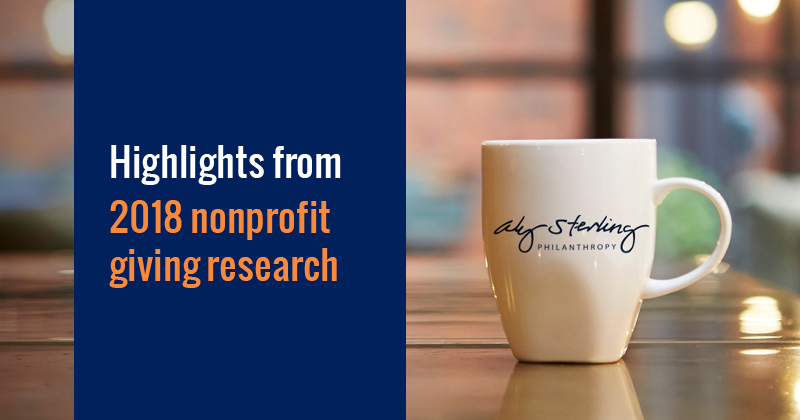
At Aly Sterling Philanthropy, our consultation is based on industry best practices and personal knowledge gleaned from decades of combined experience in the nonprofit world.
However, we recognize that the world of nonprofits and fundraising is always evolving. In order to stay on top emerging opportunities and challenges, we routinely review new research published about the sector.
Last year was an interesting year, and our research highlights below bring the proof. We’ve organized the information under five key themes. In addition to the overviews and sources, we’ve included key takeaways that you can apply to your own program. Happy reading!
Five key themes for 2018:
- Women are active in philanthropy and engaging with activism in new ways.
- Generations are giving differently and younger generations are more involved and active in philanthropy than ever before.
- Giving Tuesday continues to grow and mobile giving is more important than ever for charities.
- High net worth (HNW) donors continue to give at unprecedented rates and are influencing philanthropy in major ways.
- Miscellaneous bits of information and data we found interesting…

Women are active in philanthropy and engaging with activism in new ways.
The Rising Activism in Women’s Philanthropy – forbes.com1
- “This new wave of donor activists isn’t one-dimensional and that’s what’s so exciting. They are Millennials, they’re Gen Y, they’re Gen Z, they’re stay-at-home moms and work-outside-the-home moms, they’re single, they’re married, they work in tech, in finance, in media – you name it. It’s every woman, and she’s paying to shift the policies and systems that prevent women and girls from advancing.”
Women Looking to Engage in Impact Investing – thenonprofittimes.com2
- Women veer toward a more transformational impact with their gifts.
- 82.2% of respondents were aware of impact investing and they tended to be older, have at least $5 million in net worth, and risk-taking with personal finances.
- Impact investing can be tied to social consciousness and gender equality.
- Women seek to engage more in politics and other areas and see impact investing as a potential piece to the puzzle.
TAKE-AWAY: Pay attention to women! Be cognizant of your audience and its changing demographics. Make sure your organizational information and outreach are accessible.

Generations are giving differently and younger generations are more involved and active in philanthropy than ever before.
How the Next Generation Is Changing Charitable Giving – upenn.edu3
- Generation X and millennials will be “the most significant philanthropists in history” because of the estimated $59 trillion in wealth that is currently being transferred to them.
- These next generations aren’t just waiting around – they’re starting to give an incredible amount at early stages.
- They’re focused on supporting a mission or cause that fits with personal values, fulfilling duty as a person of privilege to give back to society and seeing that contributions make a real difference and that organizations have real impact.
Modern Donors are Changing How Charities Should Raise Money – philanthropy.com4
- Modern donors are more likely to do research about their charities, engage with their family and friends, and use more channels to give.
Study: Generations are Changing and So Should Fundraising – thenonprofittimes.com5
- With the exception of baby boomers, each generation has seen a decline in the percentage of cohort members who say they give to charity since 2013.
- Baby boomers say they gave nearly $60 billion to nonprofits last year (41% of all given).
- More than 20% of Gen-Xers say they expect to increase their giving in the coming year.
- Approximately 34 million millennials contributed 14% of all money donated over the past year.
TAKE-AWAY: Make sure you’re reaching out to donors in a variety of ways. Send letters, emails, use social media, connect in-person, etc. With such a difference in how generations interact with charities, it’s necessary to think broadly and offer multiple ways for people to engage.

Giving Tuesday continues to grow and mobile giving is more important than ever for charities.
Point-of-sale fundraising, such as the option to give to charity while checking out at the grocery store, is effective more than 71% of the time, according to the Better Business Bureau, – fox10tv.com6
Things Data Tells Us About Giving Tuesday – philanthropy.com7
- Giving Tuesday donors are younger than the average supporter (median age of 25) and 63% of donors are women.
- Organizations acquire three to five times more new supporters on Giving Tuesday than other days of the year.
- 15% of donors acquired give again before the next Giving Tuesday event.
Giving Tuesday on its Way to Record – thenonprofittimes.com8
- Five platforms that processed donations on Giving Tuesday 2018 reported a combined $336 million raised.
- Average gifts were 10% higher and the volume of mobile giving was up 12%.
- 46% of donations came from a mobile device.
- Nonprofits receiving online donations grew by 16% and the data will likely show medium and small organizations benefitting a lot.
TAKE-AWAY: Pay attention and put effort into Giving Tuesday! Get ambassadors to rep your organization online, make a goal, ask your board and volunteers to participate. And make sure online giving is easy and accessible, especially for mobile users.

High net worth (HNW) donors continue to give at unprecedented rates and are influencing philanthropy in major ways.
Has the New Tax Law Stopped People from Giving to Charity? – marketwatch.com9
- 84% of HNW donors said they expect to maintain their giving levels and 4% said they intend to increase that amount in 2018, regardless of the new tax law.
New Report Weighs Costs of Top-Heavy Philanthropy – thinkadvisor.com10
- The share of contributions from wealthy donors has increased significantly over the past decade, rising from 30% of all charitable deductions coming from households earning $200,000 or more in the early 2000s to 52% by 2017.
- Mega-gifting has surged: the threshold for mega-gifts in 2012 was $50 million or more and by 2017, the threshold for mega-gifts jumped to $300 million or more.
- The number of donors who give at typical donation level has been falling for more than 15 years, declining by about 2% a year.
TAKE-AWAY: Major donors are still giving to philanthropy, regardless of tax law changes, and are heavily influencing charity – so be aware! Make sure you’re sticking to your mission and your programming regardless of gifts received. Ensure gifts you’re accepting directly align with your work.

Miscellaneous bits of information and data we found interesting…
- The average American charitable donor receives 18 messages (8 mailings, 10 emails) from nonprofits per week. More than half of mail (54-58%) comes from organizations they don’t currently support. – afpnet.org11
- Donors choose charities based on results (32%), trust (28%) and personal connection (22%). – philanthropy.com12
- The outburst of “rage philanthropy” triggered by President Donald Trump’s agenda is dwindling, with charitable giving and advocacy returning to pre-inauguration levels – possibly due to “advocacy fatigue.” – fastcompany.com13
Giving USA 2018
- Religious giving is at one of its lowest points; fewer people giving, more “nones.” This has a ripple effect to individual giving – less people are learning about giving and contributing regularly.
- This is the longest period of growth in giving we’ve seen: 2.1% of GDP and has stayed there since roughly the year 2000. The rate is held in place right now by the top 1% of donors.
TAKE-AWAY: Giving is still growing but is changing – in the ways people are donating, connecting with charities, where they’re giving, etc. Heavy mail is not influential, and donors want to trust your organization. Be transparent! Share what’s happening, good and bad, and invite participation.
- https://www.forbes.com/sites/marianneschnall/2018/02/02/the-rising-activism-in-womens-philanthropy/#37f537ce44a9
- http://www.thenonprofittimes.com/news-articles/women-looking-engage-impact-investing/
- http://knowledge.wharton.upenn.edu/article/generation-impact/
- https://www.philanthropy.com/article/Modern-Donors-Are/243077
- http://www.thenonprofittimes.com/news-articles/study-generations-changing-fundraising/
- https://www.philanthropy.com/article/6-Things-Data-Tells-Us-About/
- http://www.thenonprofittimes.com/news-articles/givingtuesday-on-its-way-to-record/
- https://www.marketwatch.com/story/has-the-new-tax-law-stopped-people-from-giving-to-charity-2018-11-27
- https://www.thinkadvisor.com/2018/11/21/new-report-weighs-costs-of-top-heavy-philanthropy/
- http://www.afpnet.org/Audiences/ReportsResearchDetail.cfm?ItemNumber=49973
- https://www.philanthropy.com/article/Donors-Were-Asked-What-Charity/244496
- https://www.fastcompany.com/40537186/trump-inspired-rage-philanthropy-may-be-burning-out